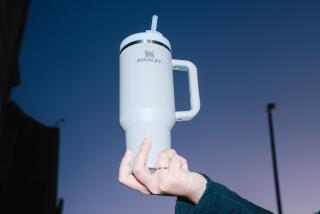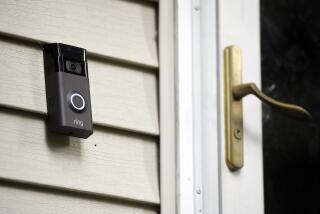Drug Giveaways Become a Headache
Under assault in California and other states over the cost of prescription drugs, manufacturers are increasingly touting their donations of medicine to sick poor people. But some of the ill and their advocates say the free drugs are not as easy to obtain as the industry suggests.
They complain that manufacturers change application criteria without notice, require income documentation that many homeless and mentally ill patients cannot provide and establish other bureaucratic prerequisites that block many needy people from getting help.
Though these private-sector charity efforts vary greatly from company to company, some have become more restrictive in recent years, according to healthcare clinic officials who help the sick apply for free drugs.
“They’re not easy programs to work with,” said Douglas Del Paggio, pharmacy director for Alameda County Behavioral Health Care Services in Oakland.
He said the percentage of prescriptions that drug companies filled for his clients dropped from 20% in 2002 to 13% last year because of changes in the way the firms dispense their drugs.
Eligibility rules differ among the more than 200 free-drug programs, and often are kept secret even from applicants. But companies most commonly make the drugs available to people who earn no more than twice the federal poverty level ($19,140 for an individual) and who lack both prescription drug insurance and access to government programs.
Nationwide, companies gave away $4 billion in medicine last year by filling 22 million prescriptions, according to Pharmaceutical Research and Manufacturers of America, the industry’s trade group.
Overall, drug firms filled 3.5 billion prescriptions in the United States in 2004, according to IMS Health, a Connecticut-based company that analyzes the pharmaceutical industry.
The oldest firms have been offering free drugs for more than half a century.
At first, company representatives simply dropped off samples at doctors’ offices. But as the number and size of manufacturers proliferated, companies set up more formal programs in which individual patients apply for the free drugs. Some firms still deliver bulk donations of drugs to clinics, however.
“We believe it’s important for people to have access to our medicine,” said Andrea Bevacqua, director of Pfizer’s drug assistance programs, which last year gave away $1 billion worth of medicine -- a quarter of the industry’s total donations.
Those who master the bureaucracies and qualify for free drugs say they are a godsend.
Susan Wells said that for 13 years without interruption, pharmaceutical companies gave her uncle in Pittsburgh the three drugs he needed to fight his cancer. “More people need to be aware that there is help for them,” she said.
Marcia Wallin, a volunteer patient advocate in Hersey, Mich., who helped arrange for her elderly parents to get discounted and free drugs, said: “There are hundreds of thousands of people across the country who absolutely cannot afford their medications due to loss of work, no prescription insurance coverage, too great an income for Medicaid assistance, who literally owe their life to the assistance of these drug company programs, and I applaud these companies for their efforts to help.”
But healthcare clinics, which have been dealing with the companies for years, say obtaining the drugs can be so complex that many clinics have had to hire full-time staff members who do nothing but help patients with their applications.
“Some of the programs are designed to measure their success by how many drugs they give away, and some of the programs seem designed to measure their success by how few drugs they give away,” said Dr. Richard J. Sagall, who runs NeedyMeds, a Philadelphia-based nonprofit that provides information on company programs at www.needymeds.com.
When Medicine for People in Need, an Oakland-based group devoted to improving access to pharmaceuticals, surveyed California healthcare clinics in 2002, it found that 48 of 214 clinics did not even apply for drugs from the programs.
Some companies require that a person be rejected for Medicaid programs -- a process that can take months -- before being eligible for free drugs. Dozens of firms require tax returns, paycheck stubs or other documentation that patients are too poor to afford the drugs. Many of the most desperate patients are homeless, mentally ill or work off the books and do not have financial records.
“I had a fellow who went around collecting cans, and at the end of the day he cashed them in for a small sum,” said Lynn Bramwell, patient assistance program coordinator for Yolo County, west of Sacramento. “He was homeless, and that’s what he lived on. We tried to enroll him for some diabetic medicine. The company said, ‘We need some sort of documentation for his income.’ And I said, ‘He collects cans.’ ”
Bramwell said the company refused to provide the medication, and he never heard from the homeless man again.
NeedyMeds says income documentation is required by 115 of the 219 programs it tracks.
Patient advocates report that eligibility rules have been getting tougher.
“I have seen it become extremely more restrictive and difficult to maneuver. They’ve become more labor-intensive,” said Susan Mister, who runs the patient assistance program at Santa Clara Valley Medical Center in San Jose. “To a certain extent I understand that, because the pharmaceutical companies are providing a lot more free drugs.... But I do think they are tightening the reins.”
Ruthe Doerksen, a retired school secretary who lives outside Modesto, said she has been turned down by program after program even though she lives on just $17,000 a year and requires six medications a day, costing her about $325 a month. She said the companies never explained why she did not qualify for free medicine.
“Each time, I have been told I’m not poor enough,” Doerksen said. “I don’t know why. They just tell me I’m unqualified.”
Some companies cancel or suspend their programs without notice, according to clinicians and patient advocates.
King Pharmaceuticals, which makes cardiovascular and women’s health medicines, has not accepted new patients for more than a year, saying its program is “oversubscribed.”
AAI Pharma, which makes pain-management medications, ended its program in November. American Regent this year stopped providing free Dexferrum, which is used by people with serious iron-deficiency anemia.
Representatives of the three companies either did not return phone calls or declined to discuss why they canceled their programs.
Dr. Jamie Garcia, director of the Pomona Community Health Center, said Bristol-Myers Squibb at one point stopped providing Monopril 40, a blood pressure medicine that has been shown in studies to prevent kidney disease.
“We had been writing applications to BMS, and they had been generous,” he said. “All of a sudden, the medicine stopped coming and our shelves were bare. They said, ‘We just don’t have that right now; we’re out of it.’ ”
A spokesman for Bristol-Myers Squibb, which gave away $500 million worth of drugs in the United States last year, said the delay was due to the fact that the drug was on back order for retailers as well as its charitable foundation. The spokesman described it as an “isolated incident.”
Though the industry advertises its medicines aggressively for the retail market, many companies have been relatively modest about their free programs until recent years. But many firms don’t mention their programs at all.
As momentum has grown in state legislatures to permit cheaper Canadian drug imports and to force companies to lower prices for moderate-income patients, however, the drug makers have reversed course.
In March, the industry trade group Pharmaceutical Research and Manufacturers of America pledged $10 million to create a clearinghouse to help direct Californians to 350 drug programs run by manufacturers, nonprofits or governments.
The industry is running television and print ads, and mailing out literature that direct people to a new website, Rxhelp4ca.org, and a phone-call center. In April, the trade group launched a similar outreach effort nationwide.
“Every year we’ve been looking, upgrading how people can use patient-assistance programs,” said Mark Grayson, a spokesman for Pharmaceutical Research and Manufacturers of America. “We want to make sure these programs are utilized as much as possible.”
The publicity comes as the industry tries to fight off Democratic efforts in Sacramento to compel drug companies to offer heavily discounted drugs to people with incomes up to four times the federal poverty level, or $38,280 for an individual.
The industry last month failed to persuade Democratic lawmakers to accept a more modest deal it had crafted with Gov. Arnold Schwarzenegger.
“Part of what they’re doing is to try to increase the visibility [of free drug programs] as they go into this legislative battle,” said state Sen. Deborah Ortiz (D-Sacramento), chairwoman of the state Senate Health Committee and sponsor of the industry’s failed measure. “That opens them up to criticism about whether these programs operate effectively.”
The drug industry says its new outreach efforts will make it far easier for people to find programs for which they qualify.
Since the effort began March 16, more than 34,000 people have called or looked at the website, and 64% of them found at least one program they qualified for, the industry says.
The prospect of free-drug programs gaining in popularity has some longtime recipients nervous that the companies might start to limit access.
“I had to ... work to find out about these programs, and I think it should stay that way,” Tina Lincheski, a Kankakee, Ill., recipient of free drugs, said in an e-mail.
“Yes, some of the applications are hard and some of the qualifications are hard to meet as well, but shouldn’t it be that way?” she said. “It shouldn’t be handed to you on a silver platter.”






